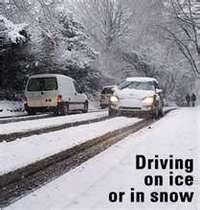CINCINNATI--January 9, 2013: According to the National Highway Traffic Safety Administration (NHTSA), an estimated 32,310 motor vehicle traffic fatalities occurred in 2011. 1 With snowfall and the potential for icy roads now part of many forecasts, it's even more important for drivers to be cautious and follow the rules of the road. To remind commuters to avoid hazardous driving behaviors, Cintas Corporation , a leader in first-aid and safety products, has identified the seven worst driving offenders.
“With defensive driving training, workers will be more inclined to keep their eyes on the road, their hands on the wheel and their mind on safe driving behaviors”
"Many drivers on our nation's roads and highways pose a safety threat to themselves and others," said Nancy Petersen, Senior Marketing Manager, Cintas First Aid & Safety. "Learning the dangers of bad driving habits is the first step in breaking drivers of risky behaviors and preparing them for the road ahead."
The seven worst driving offenders are:
1. The Beauty Queen -- Women have been known to occasionally apply lipstick, mascara and even nail polish while driving. But without both hands on the wheel and eyes on the road, it's easy to lose control of a vehicle. To avoid a fender bender and a botched makeup application, drivers should leave beauty products in their purses at all times.
2. The Hungry Commuter -- Eating while driving is yet another habit that results in hands-free driving. Hungry commuters are often involved in accidents or near misses because they can't react quickly to sharp curves or properly handle lane changes. Drivers should take time to eat before they drive or plan a roadside stop in order to grab a meal.
3. The Tech-Obsessed -- Although many states have laws prohibiting or limiting texting or talking on cell phones, drivers still obsess over gadgets like phones, GPS systems and music controls in cars. The Centers for Disease Control and Prevention (CDC) reports that 25 percent of drivers in the U.S. admitted to "regularly or fairly often" talking on cell phones while behind the wheel. 2 Drivers should refrain from these activities since reflexes are slowed when their attention is on technology.
4. The Sleepy Traveler -- Oftentimes commuters refuse to pull to the side of the road when they feel tired, choosing instead to drive. In fact, a 2011 poll by the AAA Foundation found that nearly a third of drivers admitted to driving when they had trouble keeping their eyes open. 3 Drowsy driving has even been likened to drunk driving because it impairs reaction time and judgment. Sleepy drivers should look for a rest stop if they feel unable to keep their eyes open and concentrate on the road.
5. The Daydreamer -- These drivers are often lost in their own thoughts and thinking about everything but driving. According to the CDC, nearly 15 people die each day in the U.S. in car crashes that involve distracted driving. 4 Focusing on the road, rather than the destination, personal problems or to-dos will keep daydreamers' heads out of the clouds.
6. The Road Rager -- Road ragers are far from courteous. They tailgate, cut others off and become angry easily. To curb their emotions, drivers should allow themselves enough time to reach their destination and have patience with others on the road. If commuting via car is too stressful, they should take a mental break at a rest stop or consider alternate routes of transportation.
7. The Rule Breaker -- According to the Governors Highway Safety Association (GHSA), speed is involved in about one third of traffic deaths each year, and is a problem that has seen little improvement over the past 30 years. 5 Rule breakers are those who don't wear seatbelts, frequently speed and ignore important signs and signals. To avoid costly tickets and car accidents, drivers must take proper precaution by fastening seatbelts, watching their speed and taking note of stop signs and red lights.
"With defensive driving training, workers will be more inclined to keep their eyes on the road, their hands on the wheel and their mind on safe driving behaviors," added Petersen. "To keep employees safe when they're not in their vehicles, we also offer a wide array of safety training courses to increase knowledge of CPR, fire extinguishers, bloodborne pathogens and other important topics."
For more information on first-aid and safety solutions from Cintas, please visit First Aid Safety.



